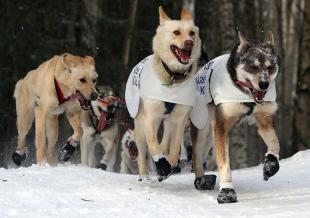Transportation Safety Lessons From the Iditarod


Office safety training may seem unnecessary if you work in an office like ours. Each day here at OpenSesame, we sit at our desks typing furiously on our laptops. It seems the greatest occupational hazard we face is carpal tunnel, or - at worst - bruises from a broken office chair.
But safety training becomes more important when your ‘office’ is an 18-wheeler... or a team of 14 sled dogs.
OpenSesame seller J.J. Keller has experience with both sled dogs and 18 wheelers - and their training demonstrates their experience and understanding of the unique challenges of keeping safe in challenging environments. J.J. Keller invests in extreme transportation by sponsoring an Iditarod musher each year and this year, their sponsored musher, Dallas Seavey (25), became the youngest person to win the Iditarod. He completed the race in 9 days, 4 hours, 29 minutes and 26 seconds.
J.J. Keller’s role as a training provider and that of a sponsor may not at first seem intrinsically linked. However, there’s a lot one can learn about transportation safety by observing what goes on during the 1,112 mile trek through Alaska.
Wait, what is the Iditarod?
The Iditarod Trail Dog Sled Race is a long-distance sled dog race run annually from Anchorage to Nome, Alaska. Mushers (dog sled racers) with teams of 12 - 16 dogs race through the freezing cold terrain in harsh conditions. During their 9 - 15 day journey, they face moose, whiteouts, and biting winds. Because of organizers’ emphasis on safety, no musher has died since the race’s inception in 1973. Here, we’ve listed the 3 core principles of transportation safety that we learned from the Iditarod.
Know the Terrain. Before the race even starts, mushers and their teams have typically run about 2,500 miles together. They know each other’s strengths and weaknesses, and have a general idea about each other’s physical limitations in a training situation. However, adding the merciless Alaskan terrain into the equation changes everything. That’s why many individual mushers or sled teams choose to participate in one of the many training races available, including the Iditarod Trail Invitational. This race gives participants the chance to bike, run or ski the full Iditarod Trail, giving potential mushers the opportunity to test the terrain.
In the same way, it’s important for transportation workers to understand the myriad situations they may find themselves in on the road. Training for driving at night, in rural areas and through extreme weather, for example, will limit the chances that drivers find themselves in a completely new scenario. Given the context to deal with a variety of on-the-road challenges will prevent catastrophe.
Prepare for the Worst, Hope for the Best. Bill Peele was exhausted. He had been riding for days with minimal sleep through the Alaskan wilderness. Determined to stay awake, a sleep-deprived, delusional Peele began stuffing snow into his clothing to keep him awake. The cold continued to erode his better judgement, until Peele tore his gloves off in hopes that the pain would keep him from dozing. By the time he decided to make a pit stop for some necessary shut-eye, his hands were consumed by frostbite. Unable to open his sled bag to retrieve his sleeping bag, Peele deliriously laid down beside his sled for repose. A villager found him there, on a trail outside of Shageluk, and alerted rescuers - just in time to save the musher. In a later interview, he revealed to reporters that - in the case of his death - he recorded a ‘goodbye’ to his wife and kids.
This incident in 1991 exemplified the importance of being prepared for the worst. Though Peele had trained for the physical intensity of race, he had a difficult time adapting to the sleep deprivation and intense cold. Understanding the risks wrapped up in the ‘worst case scenarios’ and preparing for those will help you avoid ever having to respond to injury or death. In the transportation industry, this means training drivers on emergency maneuvers to prevent accidents, and accident procedures to minimize the effect of accidents.
Practice Good Self Care. No one is going to make your safety a priority but YOU. This is especially true in the Iditarod race, where mushers and their teams may race for many hours without seeing another soul. Carrying enough personal survival gear tends to be the downfall of many mushers, says Jack Niggemeyer in this Anchorage Daily News piece. Their focus on winning the race distracts them from their own personal safety. Professional drivers may similarly ignore their personal safety needs in the pursuit of cash incentives. Make sure they understand the risks involved with this sort of distracted driving, and how to minimize these risks.
(Image Source: Alaskan Dude's Flickr)



